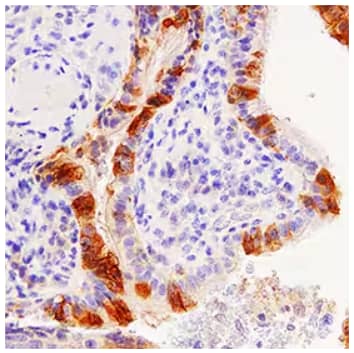Even though the direct detection method is becoming more popular for immunofluorescence (IF) and flow cytometry experiments, the indirect detection method still remains the preferred choice for many other applications. In direct detection, the labeled primary antibody is responsible for both binding and detection of the antigen of interest. In indirect detection, this process is broken down into at least two distinct steps – (i) an unconjugated primary antibody forms a complex with the antigen, (ii) a labeled secondary antibody, interacting with the constant region of the primary antibody, facilitates detection.

HAI-1 was detected in paraffin-embedded sections of human lung cancer using goat anti-human HAI-1 ectodomain antigen affinity-purified polyclonal antibody (Catalog # AF1048) followed by anti-goat IgG VisUCyte HRP polymer antibody (Catalog # VC004). Tissue was stained with DAB (brown) and counterstained with Hematoxylin (blue; Catalog # 5222).
Enhanced Sensitivity
One of the main reasons for using the indirect method is an increase in the lower limit of detection. Since two or more labeled secondary antibodies are able to bind a single primary antibody, the result is an amplification in signal and an increase in assay sensitivity. This is particularly important for low abundance antigens which may require additional signal amplification steps to generate an appreciable signal over background staining. One option for signal amplification using chromogenic detection is an HRP polymer-conjugated secondary antibody in which multiple HRP molecules are associated with each secondary antibody. Learn more about signal amplification methods from our IHC Detection page.
Greater Flexibility
With the indirect method, researchers aren’t restricted by the range of commercially available conjugated primary antibodies; nor are they limited to using a particular label for an experiment. Instead of worrying about choosing the best label, e.g. FITC or PE, for the primary antibody, the primary antibody can be paired with different conjugated secondary antibodies from the same species. You can also easily shift from a colorimetric to a fluorescent assay when working with an unconjugated primary antibody.
Studying a novel antigen or using a new antibody introduces a number of unknowns such as antigen abundance and successful antigen-antibody binding. The indirect method of detection may be a more suitable starting point for your experimental design. Your lab may already have an inventory of conjugated secondary reagents that you can use for preliminary testing.
Conjugated secondary antibodies enrich the detection of low abundance target molecules and allow greater freedom in choosing detection reagents. Bio-Techne has an extensive catalog of conjugated secondary antibodies available for your indirect detection needs.